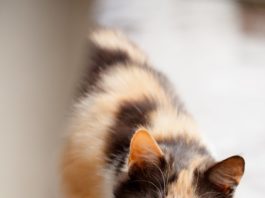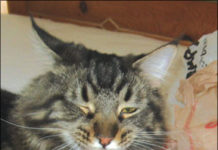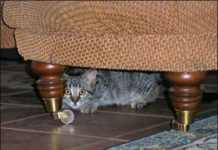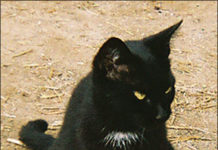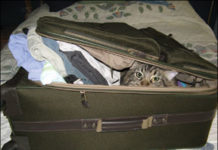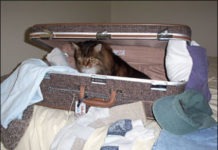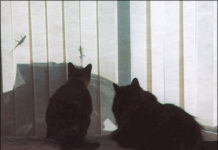Ask Elizabeth: 04/08
Dear Elizabeth, I have four cats in my household and one of them, Tabitha, has a tendency to chew and eat plastic. Ive caught her chewing on plastic bags that Ive carried in from the store, as well as items in the basement that are wrapped in plastic. I worry that she could choke to death or hurt herself somehow. Why does she do this? One of my other cats is aggressive and chases her. Tabitha is afraid and will not fight back; could her plastic obsession be stress-related? Any ideas of what I can do?
Cats That Hate Company
When Kit, a 12-week-old female kitten, earnestly beckoned from her cage in a Manhattan animal shelter, Miriam knew she was the one. Miriam was lucky to adopt Kit, as many people had been admiring her. Kit settled in with Miriam and her two roommates in a small apartment. Kit loved everyone; Miriam was even jealous when Kit would occasionally sleep on her roommates beds instead of her own. Kit played and romped and greeted people at the door as she grew into young cat-hood. A year later, however, Kit is a feline terror. "I dont know what happened," says Miriam, "but Kit now attacks people when they come in; she scratched my aunt who came to visit. No one wants to come to my house anymore, including my boyfriend! But shes so lovable to me."
Cats and Kids: Making Friends
I recently received a letter asking me whether there was any way to improve the relationship between a cat and a child. The question seems particularly relevant as we move beyond the holiday season and begin to plan for summer gatherings. Our cats are important members of our families. We refrain from placing tinsel on our trees, since it is dangerous to our pets. Cats are invited to partake in holiday meals by sampling a bit of the roast in their bowls. We offer catnip as we sip our holiday wine. And yes, sometimes we fit our felines with antlers, halos and other festive garb.
Making a Move?
Moving day can be a miserable, hectic blur - one of those times youd like to be able to just twitch your nose and be done with it. Unfortunately, it just isn't that easy. And cat owners have the added stress of worrying about how their cat(s) will react to the disorder and mayhem. However, there are several precautions that can be taken to help ensure that your pet will remain safe during the move and to promote a quick adjustment to his new home. Losing your cat on moving day is something to be avoided at all costs. Julia Albright, DVM, a resident in animal behavior at the Cornell University Hospital for Animals, explains, "Dealing with a lost pet on such a busy day is a nightmare. Pets are notorious for sneaking out on moving day; confining the cat to a bedroom or bathroom with a note on the door is a great idea." Make sure that the cat has food, water, litter and is comfortable - and then close the door and put a highly visible note on it, spelling out in no uncertain terms that the door must remain closed. Not only will this reduce the cats anxiety at seeing everything familiar removed from the home, but it will also help ensure that the cat does not dart out an open door. When it comes time to transfer the cat, crate her while shes in the confinement area and double-check the latch before opening the door.
Ask Elizabeth: 01/08
Dear Elizabeth: My feline housemates and I think your column is always interesting and informative. But we are beginning to wish our person would stop reading it to us, because now she wants to know why we cant write a column and be famous like you. I spend a lot of time on the computer - I mean, I even sleep on that keyboard! - but nothing good ever comes of it. And besides, Ive always thought that it was quite enough to be beautiful, well groomed and purrfectly delightful. How can I get my person to stop finding fault where there obviously is none?
Kitty Kindergarten
Imagine a cat that goes into its carrier on command, sits calmly while its claws are clipped, lies down for grooming and knows a few tricks. And while youre dreaming of the perfect feline, add this idea to your fantasy: The cat takes pills easily and actually uses the scratching post - and not the back of your couch. Wake up! It was a nice dream, wasnt it? Actually, this image of a feline housepet may not be so far-fetched - particularly if cat owners take advantage of a new training concept called "kitty kindergarten." The program is very similar in purpose to "puppy preschool" in that its main focus is to save pet lives by educating owners - and having some fun along the way.
How to Convert the Outdoor Cat to Indoor Pet
Several years ago I came home to my first apartment and was greeted by my best friend, grinning from ear to ear. "Theres a surprise in your bathroom!" she exclaimed. That surprise turned out to be an adorable stray kitty from her hometown. "Nana" soon revealed herself to be an amazingly adaptive cat that was happy just basking in our love and attention, but the road to domestic bliss was certainly not without its bumps. In hindsight, there were several steps we could have taken to make the transition a bit smoother. In fact, there are several potential problems when bringing an outdoor cat (e.g. a neighborhood stray or barn cat) indoors to live; however, if a new owner anticipates these problems - and addresses them accordingly - they can be greatly minimized.
Cats With Double Lives
Recently, a woman asked for advice in a chat room for pet enthusiasts. She explained that her outdoor cat would go off for days, sometimes a week at a time. Naturally, she would worry about him. Then, just as mysteriously as he had left, he would show up again at her door and make himself at home as if he had never left. One day during one of her cats absences, the woman went to visit a neighbor down the street. As the neighbor asked her in for a cup of coffee, the woman shouted, "Theres my cat!" Indeed, there was her cat lounging on her neighbors couch.
Short Takes: 12/07
Rushed to the Veterinary Teaching Hospital at Kansas State University, the year-old cat had been coughing, vomiting and suffering abdominal pain. When all was said and done (yes, she survived, thanks to surgery) the cat was the subject of a report, "Diagnostic imaging for linear foreign bodies in cats," in the journal, Veterinary Medicine (Vol. 102, Issue 8). The cats owners got lots of pictures - from imaging techniques that included survey radiography, compression radiography, ultrasonography and positive contrast upper GI radiography. And veterinary science learned which techniques work best: compression radiography (something like a mammogram of the abdomen) and ultrasound.
Ask Elizabeth: 11/07
Dear Elizabeth, I cant help feeling envious of the absolutely beautiful photos that have been taken of you. You are clearly a stunning cat of exquisite beauty, but I wonder how the photographers at the Feline Health Center have been able to capture your soul in their photos. I would dearly love to have some similar photos of my equally beautiful cats, but all I get are fuzzy, out-of-focus shots of their tails as they flee the room, or photos where their eyes are red and they look devilish. Do you have any tips that you could share?
The Attention-Hungry Cat
Bandit sits on a white plastic grocery sack (with the handles slit so she doesnt become trapped). Sitting on a sack is her persons cue that Bandit wants to play a game. Growltigger sits on papers in front of the computer screen whenever his owner is trying to type. Ziba jumps on newspapers spread out on the dining room table when someone is reading them there. Thomas Mountain Lion climbs on bags of recycled paper that make crunching noises when he moves around on them. Place a throw rug on the floor, even if its on top of wall-to-wall carpet, and Migraine will sit on it. Place a folded fuzzy blanket at the end of the bed, and Merry stretches out on it. Stacks of books, stacks of clean clothes, stacks of reports from your tenth grade history class - set them on the floor, and your cat is likely to perch on them.
“Gifts” From Your Cat
Cats are born with a chasing and hunting instinct, but not necessarily the skill to go along with it. The mother cat teaches her kittens to kill and eat prey. (Indoor cats may chase and kill mice, but rarely eat them.) The lessons start when the kittens are about four weeks old. The mother cat begins by bringing home dead mice or other prey and eating them in front of the kittens. The kittens soon catch on and join in. Next, the mother cat brings home dead mice and the kittens eat on their own.





